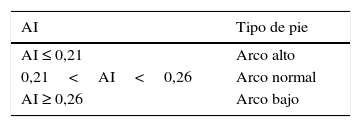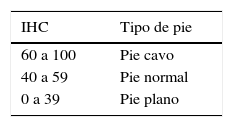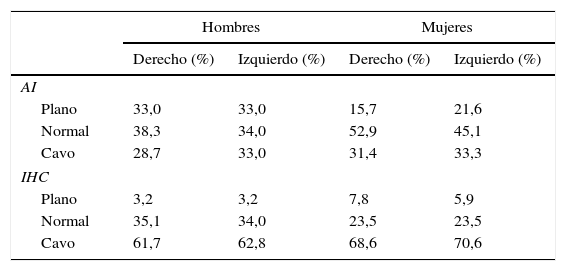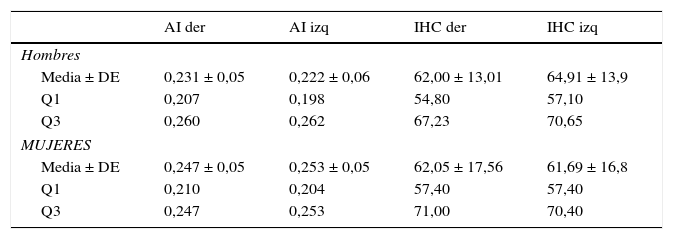El objetivo de este estudio fue analizar dos metodologías cuantitativas de evaluación del arco plantar longitudinal medial del pie (APLM) en una muestra de sujetos activos chilenos.
Material y métodoEn una muestra de 145 estudiantes universitarios de ambos sexos de 19,36 ± 1,76 años de edad; 1,68± 0,09 m de estatura y 67,04± 12,00 kg de masa corporal, se obtuvo la huella plantar desde fotopodoscopia, y luego fue analizada según el Arch Index (AI) y el índice de Hernández Corvo (IHC).
ResultadosLa comparación entre IHC y AI en un mismo pie arrojó que en hombres se encuentran diferencias significativas, en pie derecho (p<0,0001, ES=0,9577) y en pie izquierdo (p<0,0001, ES=0,9560). En mujeres también se encuentran diferencias significativas en pie derecho (p<0,0001, ES=0,9264) y en el izquierdo (p<0,0001, ES=0,9314).
ConclusionesEl AI ha demostrado ser más apropiado que IHC para evaluar los pies de esta muestra, por su consistencia al emplear áreas de apoyo plantar y al excluir el área de apoyo de los dedos. Además, se demostró que los valores originales empleados para la clasificación del tipo de pie coincidieron con los valores encontrados en esta muestra.
Se sugiere emplear en esta población el AI y su clasificación original. No obstante, se hace la advertencia de que en mujeres es necesario ampliar la muestra, ya que en este grupo hubo una leve diferencia con los valores originales.
The objective of this research was to analyze two quantitative methodologies of evaluation of medial plantar longitudinal arch (MPLA) in a sample of Chilean active subjects.
Material and methodIn a sample of 145 University students of both sexes of 19.36 years (±1.76) of age; 1.68m (±0.09) of height; and 67.04kg (±12.00) of body-mass is obtained the footprint from photo-podoscopy, which was analyzed according to the Arch Index (AI) and the Hernandez Corvo Index (HCI).
ResultsThe comparison between HCI and AI in a same foot generating significant differences in men, in the right (P<.0001, ES=0.9577) and left (P<.0001, ES=0.9560) feet. Women have significant differences in the right foot (P<.0001, ES= 0.9264) and also left (P<.0001, ES=0.9314).
ConclusionsAI has been shown to be more appropriate than HCI in evaluating feet in this sample, given its consistency in describing areas of plantar support, and excluding the area of support of the toes. In addition, it was demonstrated that the original values used for the classification of the type of feet coincided with the values found in this sample. It is suggested to use AI in this population and their original classification. However, it is warned that women needed to expand the sample since in this group, there was a slight difference with the original values.
Artículo
Si ya tiene sus datos de acceso, clique aquí.
Si olvidó su clave de acceso puede recuperarla clicando aquí y seleccionando la opción "He olvidado mi contraseña".Comprando el artículo el PDF del mismo podrá ser descargado
Precio 19,34 €
Comprar ahora













